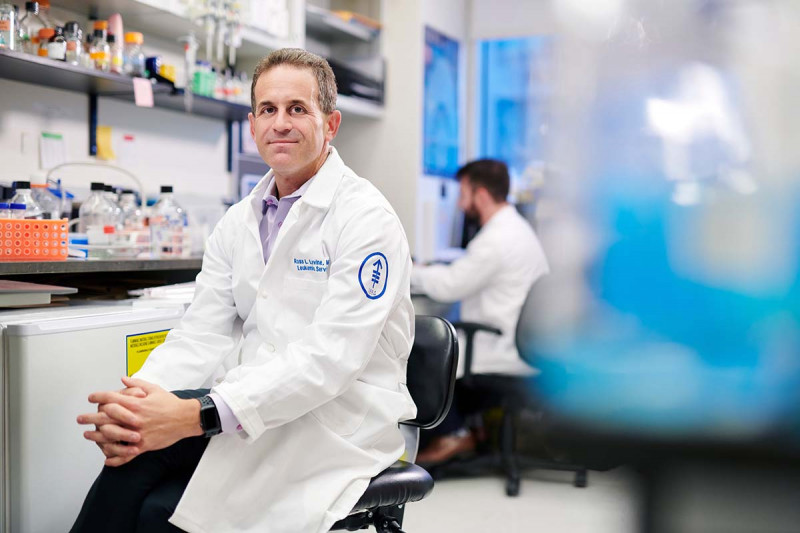
Physician-scientist Ross Levine is Director of the Center for Hematologic Malignancies. He specializes in researching and treating blood and bone marrow cancers.
Physician-scientist Ross Levine investigates the genetic basis of blood cancers. We spoke with him about his research in 2009, two years after he came to MSK to join the Human Oncology and Pathogenesis Program and Leukemia Service.
I was interested in science from a young age, growing up in the suburbs just north of New York City. I was accepted into a program at Columbia University for area high school students and spent Saturday mornings learning about biology, chemistry, math, and physics. When I entered Harvard in the early 1990s, I narrowed my focus to biology and gained exposure to clinical research, partly by shadowing physicians as they worked. This led to my decision to go to medical school.
I began medical school at The Johns Hopkins School of Medicine planning to become an academic clinical physician. One summer, to broaden my experience, I worked in the laboratory of pathologist Lora Hedrick-Ellenson, who was studying endometrial cancer. The research was fascinating, more interesting to me than any clinical experience. That brief stint in the lab caused me to consider someday becoming a physician-scientist.
Over the next four years I finished medical school and trained in internal medicine at Massachusetts General Hospital. In 2002, during my clinical fellowship in hematology/oncology at Dana-Farber Cancer Institute, I developed a specific interest in caring for patients with leukemia; however, I soon learned that most patients are not cured with existing treatments.
This led me the following year to enter the laboratory of Gary Gilliland, a leader in leukemia genetics and a fantastic mentor. Our research focused on myeloproliferative neoplasms — blood cancers — the cause of which had eluded researchers. We hoped that by identifying the cause of these cancers we could develop better therapies.
The Genetic Basis of Blood Disorders
Gary and I decided that in order to truly understand these diseases, we needed to discover the underlying genetic causes. We collected samples from patients and sequenced the DNA from their cancer cells, comparing the results to noncancerous cells from the same patients. We discovered that in two-thirds of the patients, the cancer cells had a single mutation in the gene for the signaling molecule JAK2. This suggested the JAK2 pathway was involved in several types of blood cancer.
By using patient samples as the starting point, we were able to establish evidence of what was driving these diseases. In addition to helping us understand the biological underpinnings, the finding provided targets for more-effective therapies. This experience strengthened my conviction that I wanted to work at the interface between basic research and clinical medicine.
As I was finishing my postdoctoral and clinical training, I looked for a place where I could continue this kind of work. Memorial Sloan Kettering attracted me for a number of reasons. The quality of science and clinical investigation here is amazing. Also, the Human Oncology and Pathogenesis Program (HOPP) was just getting underway, and I was enthusiastic about a program focused on bringing together physician-scientists to translate molecular insights into new therapies. Finally, I learned that Memorial Sloan Kettering had recruited Charles Sawyers, a leader in translational medicine, to serve as Chair of HOPP.
HOPP links the lab to the clinic; I hold a joint appointment on the Leukemia Service, and my laboratory research is facilitated by seeing patients in the clinical program. In my lab, I continue to focus on blood cancers, seeking to illuminate the genetic basis for the activation of signal transduction pathways — how cells receive and respond to signals — and how this can lead to cancer.
So far, my lab has focused on somatic mutations, those acquired during a patient’s lifetime. But we think a person’s inherited genetic makeup affects the likelihood that a somatic mutation may lead to cancer. An inherited abnormality may lie elsewhere in the genome — and in itself have no noticeable effect on the body — but by interacting with a newly mutated gene it promotes or restricts runaway growth after the somatic mutation occurs.
Disease Pathways and New Targets
In the next few years, I think there will be three exciting developments in leukemia genetics and genetics as a whole. First, we will see a broader use of genome-wide technologies, ultimately allowing us to routinely sequence the entire genome of cancer cells. Second, there will be important advances in what we call functional genomics. This involves systematically inactivating different genes using the new technology of RNA silencing to clarify which mutations contribute to the pathogenesis of cancer and which are merely “passenger” mutations with no relevance to disease risk.
Third, and probably most important, we will bring these insights back to the clinic. Identifying mutated genes that cause cancer will present attractive therapeutic targets. For example, there now are five or six drugs in late-stage clinical trials that inhibit the effects of the JAK2 mutation.
Finally, even in the absence of a specific target based on a genetic discovery, knowing about mutations allows us to use existing therapies more effectively.


